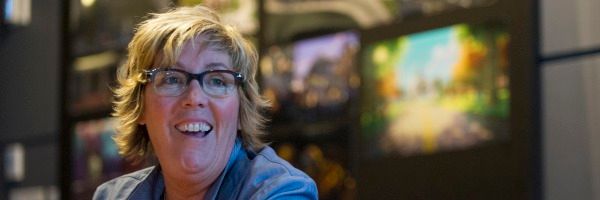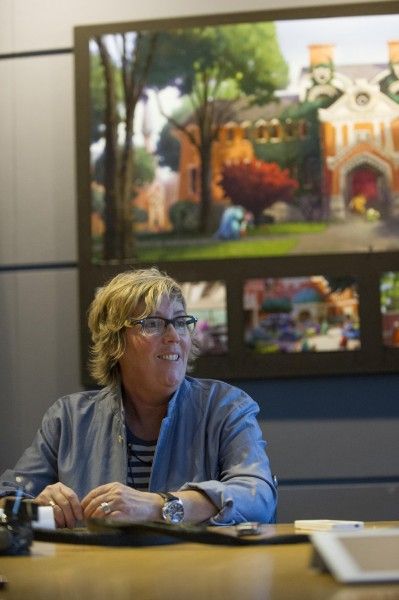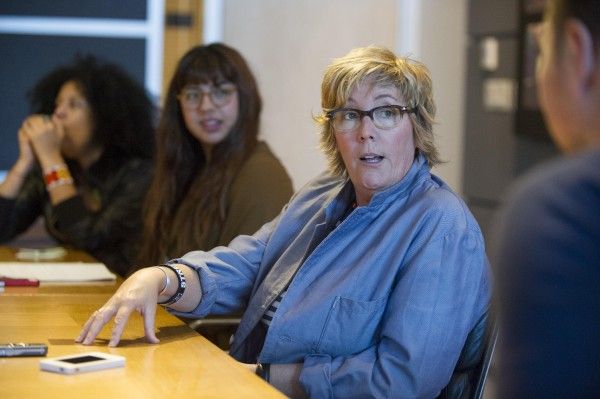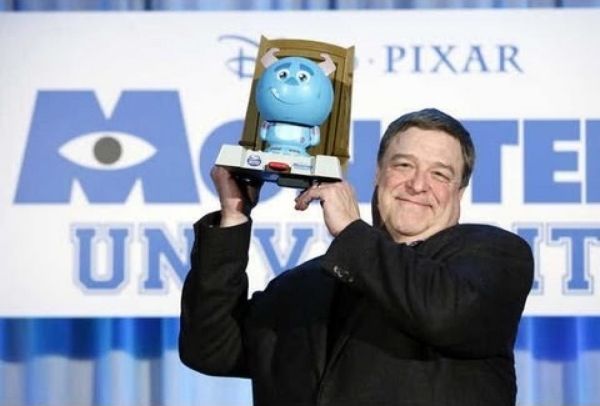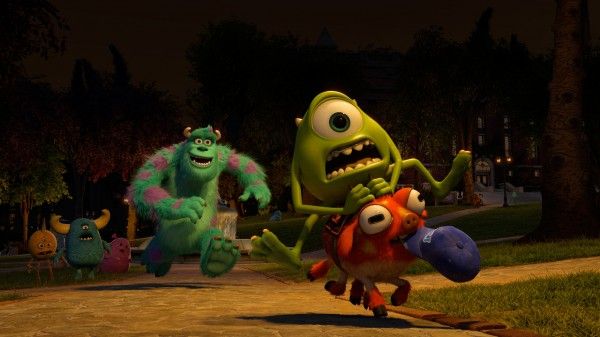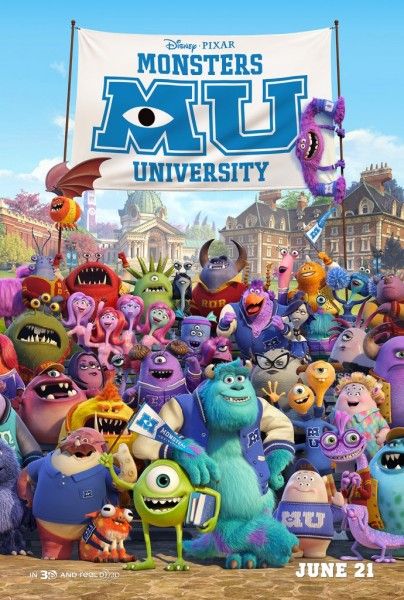As a fan of many of their movies, I’ve been wanting to go to Pixar, for some time now. And since you have to either work there, know someone who works there, or get an invite to go there, I jumped at the recent opportunity to make the trip to Emeryville, Calif.to do interviews for their latest feature film, Monsters University, and had a great time while I was there. The film follows Mike Wazowski (voiced by Billy Crystal), who arrives at the campus with the dream of becoming a Scarer while James “Sulley” Sullivan (voiced by John Goodman) feels like he doesn’t have to put in the time or work to succeed because he was born with his talent. When their journeys both prove to be a bit more complicated than they anticipated, they find help and friendship in the unlikeliest of places.
At the film’s press day, producer Kori Rae (Up, The Incredibles, Monsters, Inc.) talked about why they decided to go with a prequel to tell more of Mike and Sulley’s story, the biggest challenge in going backwards, why they chose college, the technological advances in lighting, how they got such a terrific cast of voice actors, that there might be a spin-off short featuring one of the supporting characters, and what sort of Easter eggs can be found in the film. Check out what she had to say after the jump.
Question: So why not do a sequel and tell Boo’s story? Why go with a prequel?
KORI RAE: Well, I think we actually tried to think about what would be the most interesting, if we were gonna go back and revisit these characters. And what we decided on is that it would be really great to find out who Mike and Sulley were, before we knew them. Because when we meet them at MI, they’re best friends and co-workers. They have this life set up. And so, we thought that it would be really fun to just go in and figure out, “Who were they before that, and how did they become the friends that we knew them to be in MI?” And what better way to do that than when they met each other. It just seemed like more opportunity, to be honest. So, we went backwards.
What was the biggest challenge in going backwards?
RAE: The story. Telling an unpredictable story in a prequel is difficult because you know how the story ends. And so, you need to figure out how to do that, and not make it boring or repetitive. The good thing is that we turned that on its head and used it to our advantage. We were able to say that everybody knows that Mike isn’t a Scarer, and doesn’t become a Scarer. But, what we didn't know is that that was his lifelong dream. Since he was a little kid, that’s what he wanted to do. And what that did was allow us to tell the story of, and what happened when he hit that roadblock and his dream was crushed. What then? And we felt like that was a really cool, universal message. When you fail, then what? Can you open yourself up enough to get around the corner from that failure and look to what’s next? Usually it’s better than what you’d imagined, even though you hadn’t thought it would be. So, we made it a positive thing. It was challenging, at the beginning, but it worked out.
How did you choose college, instead of another time period, like kindergarten?
RAE: We talked a lot about that, and talked about how far back to go. We really wanted to use that time in everyone’s lives when it’s about self-discovery, and we just felt like, if we went too far back, we wouldn’t be able to get that deep, in terms of a story. And so, we just thought college is the perfect time period, whether you went to school or not, where you can delve into self-discovery and what happens when you’re out in the world, on your own, for the first time, and figuring yourself out, figuring out who you wanna be, who you should be and who you can be.
Did you worry about younger children not being able to relate to it because they haven’t had that experience?
RAE: I don’t think so. The movie has fun characters in it. And it’s also just about friendship. Mike and Sulley are friends. Although they’re rivals, at the beginning of this film, we know they become friends. It’s a story about friends and teamwork, and also a lot of fun. We don’t take ourselves too seriously. We definitely wanna have fun, so I think the kids will certainly enjoy that. And it was my experience, even as a young kid, that I couldn’t wait to go to school because I wanted to be like my older friends or my siblings. I used to tag along to school with a fake notebook and pretend that I was ready to go. I think kids like school, for the most part, except for math.
There are tremendous technological advances in lighting on this film. Were those advances initiated on this production? And as a producer, how do you know if those things are actually going to pan out, in an appropriate timeframe?
RAE: Great question. We did develop a new lighting tool on this film, called global illumination. It’s not new to the world of computer animation, but it’s new to us, as a studio. It was started by a small group of people who, at the very beginning of this, came to me and said, “Hey we have an idea.” Our lighting DP came and talked to me about it, and he’d been thinking about it for awhile. There were things in lighting that he had wanted to do that mimic real lighting, in terms of set-ups. He came and he said he really wanted to try this. He wasn’t sure if it was gonna work. He knew that it would require more rendering power. He knew there would be some cost attached to it. But, the upside is that it would be easier and better to use, by the technical directors, and that we might be able to get a slightly different, richer look.
Sometimes our tools can be cumbersome. It’s just the nature of it, because we want such utter control, to make every single shot look exactly how we want. And so, lighting, in particular, hadn’t had a new set of tools in awhile. He just wanted to simplify it, so that anybody could go in and light a shot with a little more ease and, out of the gate, get something that was really close to real lighting. So, he came and talked to me about that and I said, “What do you need to give that a try?” They spent four to six months developing it, and then they had to pitch it to the studio. It’s never just about one film. It needs to be something that can be used by other films. And it looked like it had real possibility. The look was beautiful and had the potential to allow the lighting team to work more efficiently, so we took the risk and went for it. We think it really paid off.
Do you find that there are times when the technology hinders the artists, as opposed to empowering the creative process?
RAE: Yes. Limitations often spur creativity. Artists will say, “Oh, if I had all the time in the world, I could make this really great,” but the truth is, not necessarily. Sometimes a tool’s limitation causes creativity to come out, in a different and unexpected way. In terms of the schedule and time, we need that kind of restriction sometimes. I’m not saying that we want to hinder ourselves, but sometimes it can get in the way and the turnaround is a little bit longer, which is frustrating. If someone could instantaneously work on a shot and press a button and have it there immediately, that would be great, but it has to render. It has to do its thing, and then come back, so you can take a look at it. All of those things are part of the process. But, we try to not let the tools impede, in any real way. That’s what we try to stay ahead of. When it does happen, that’s what we try to address. I think the global illumination is a testament to that. One of the things that we were trying to accomplish was to make it less laborious to do the job.
Your voice cast in this is fantastic. How did you get these actors on board?
RAE: We were so lucky. We have such an awesome cast. Dan and I were always saying, “Oh, we just wanna go out and have dinner with all of them,” ‘cause they’re so nice and they’re so much fun. We were lucky enough to get a number of Pixar fans. But, the casting process is interesting. We’re not looking for actors. We’re looking for voices who embody the character that we’ve created. It’s an interestingly blind process. We write the character, we know who they have to be in the story, we design the character, and then we even start building it, in some cases. And then, we go in a room and we have the visual of who the character in the film is, and we listen to voices without knowing who they are or what their names are, and we run through and see who best fits with the actual character. That’s the most important thing. Even if it’s a great actor, if they’re not right for the character, it won’t make sense. It won’t lift the movie up or elevate the film.
Have you ever been turned down, by an actor?
RAE: Not in a long time. I think, way back in the day, we got turned down a few times, but not lately. We’re so lucky.
Did any of the characters change much, based on who was cast for the voice?
RAE: That’s a great question. Not really. Maybe a little bit with Terry and Terri. Dave and Sean did an amazing amount of improv and playing off of each other ‘cause they’re both such great comedic actors. They probably defined their characters more than they were, when we set out. Their performances brought it home even more and added a little bit to it. Sean certainly added a little more flair, and he came up with the dance major thing. They helped define their characters’ personalities. I don’t think any of them really changed, but the actors helped define them better.
Have you considered working it out, so that you can have your voice cast record together, or is that just impossible?
RAE: For sure. We’re always open to it. There is a complexity that comes with it, from a directing and a performance standpoint. Sometimes it’s really effective. In the case of Billy and John, it was just fantastic. They were in the room together, and a lot of their scenes are the two of them together. And in the case of the twins, Terry and Terri, we recorded Sean [Hayes] and Dave [Foley] together. They share one body in the film, so we thought it would be great to get them together, and it really was. So, I think that, if the film itself calls for it and the director is into it, we would do that, but it does add a level of complexity. We’re very specific about performances. While recording as a group may change the dynamic, we also spend an inordinate amount of time going through every single take, from a recording session, and really making sure we’re putting the best performances together, from the artists. It’s important to be able to have the flexibility of getting them alone, as well. I think it all comes back to what the film needs.
What are the challenges in adding so many new characters that are interesting and funny in their own right, but keep them as just adding to the story of Mike and Sulley, as opposed to taking away from it?
RAE: That’s part of the every day challenge for the story team and the director, to make sure that that balance is right for the film. You don’t want it to be too much, but you also need it to be enough, so that they there’s enough to latch onto and an audience member can go, “Oh, yeah, I like that character because I understand them or I know enough about them.” That’s one of the nuances of working on the story and making sure that that balance is good and correct, and that you see them enough, where you need to.
Are there any of the supporting players in this, that you’d like to see get a short film or a spin-off?
RAE: I don’t know. There might be one out there, coming your way. We’ll see.
Are there any Easter eggs you think people should look out for?
RAE: I think there’s a few. We have some, but I don’t wanna give any away ‘cause that would spoil the fun. Traditionally, there are some that we put them in all of our films, and they’re all there. We also try to pay an early homage to the film that’s coming out next. There’s something in there for the next film that comes out, next year.
Monsters University opens in theaters on June 21st.

